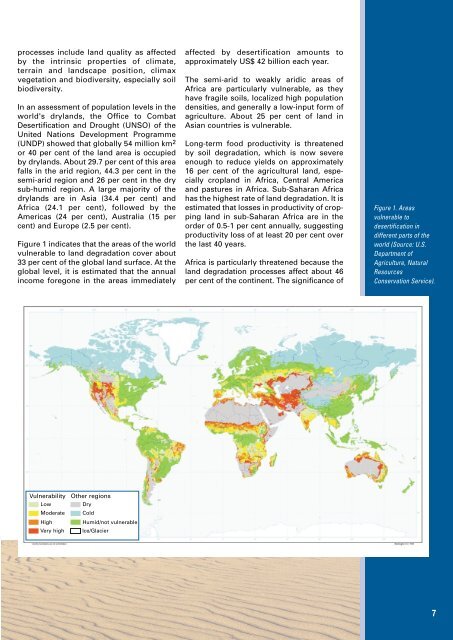Climate and Land Degradation - WMO
Climate and Land Degradation - WMO
Climate and Land Degradation - WMO
Create successful ePaper yourself
Turn your PDF publications into a flip-book with our unique Google optimized e-Paper software.
processes include l<strong>and</strong> quality as affected<br />
by the intrinsic properties of climate,<br />
terrain <strong>and</strong> l<strong>and</strong>scape position, climax<br />
vegetation <strong>and</strong> biodiversity, especially soil<br />
biodiversity.<br />
In an assessment of population levels in the<br />
world's dryl<strong>and</strong>s, the Office to Combat<br />
Desertification <strong>and</strong> Drought (UNSO) of the<br />
United Nations Development Programme<br />
(UNDP) showed that globally 54 million km 2<br />
or 40 per cent of the l<strong>and</strong> area is occupied<br />
by dryl<strong>and</strong>s. About 29.7 per cent of this area<br />
falls in the arid region, 44.3 per cent in the<br />
semi-arid region <strong>and</strong> 26 per cent in the dry<br />
sub-humid region. A large majority of the<br />
dryl<strong>and</strong>s are in Asia (34.4 per cent) <strong>and</strong><br />
Africa (24.1 per cent), followed by the<br />
Americas (24 per cent), Australia (15 per<br />
cent) <strong>and</strong> Europe (2.5 per cent).<br />
Figure 1 indicates that the areas of the world<br />
vulnerable to l<strong>and</strong> degradation cover about<br />
33 per cent of the global l<strong>and</strong> surface. At the<br />
global level, it is estimated that the annual<br />
income foregone in the areas immediately<br />
affected by desertification amounts to<br />
approximately US$ 42 billion each year.<br />
The semi-arid to weakly aridic areas of<br />
Africa are particularly vulnerable, as they<br />
have fragile soils, localized high population<br />
densities, <strong>and</strong> generally a low-input form of<br />
agriculture. About 25 per cent of l<strong>and</strong> in<br />
Asian countries is vulnerable.<br />
Long-term food productivity is threatened<br />
by soil degradation, which is now severe<br />
enough to reduce yields on approximately<br />
16 per cent of the agricultural l<strong>and</strong>, especially<br />
cropl<strong>and</strong> in Africa, Central America<br />
<strong>and</strong> pastures in Africa. Sub-Saharan Africa<br />
has the highest rate of l<strong>and</strong> degradation. It is<br />
estimated that losses in productivity of cropping<br />
l<strong>and</strong> in sub-Saharan Africa are in the<br />
order of 0.5-1 per cent annually, suggesting<br />
productivity loss of at least 20 per cent over<br />
the last 40 years.<br />
Africa is particularly threatened because the<br />
l<strong>and</strong> degradation processes affect about 46<br />
per cent of the continent. The significance of<br />
Figure 1. Areas<br />
vulnerable to<br />
desertification in<br />
different parts of the<br />
world (Source: U.S.<br />
Department of<br />
Agriculture, Natural<br />
Resources<br />
Conservation Service).<br />
Vulnerability<br />
Low<br />
Moderate<br />
High<br />
Very high<br />
Other regions<br />
Dry<br />
Cold<br />
Humid/not vulnerable<br />
Ice/Glacier<br />
7












![View full document [PDF 988.55 KB] - PreventionWeb](https://img.yumpu.com/47733942/1/184x260/view-full-document-pdf-98855-kb-preventionweb.jpg?quality=85)
![View full document (in French) [PDF 4.96 MB] - PreventionWeb](https://img.yumpu.com/47223870/1/184x260/view-full-document-in-french-pdf-496-mb-preventionweb.jpg?quality=85)


![View full document [PDF 25.02 MB] - PreventionWeb](https://img.yumpu.com/44204570/1/190x234/view-full-document-pdf-2502-mb-preventionweb.jpg?quality=85)
